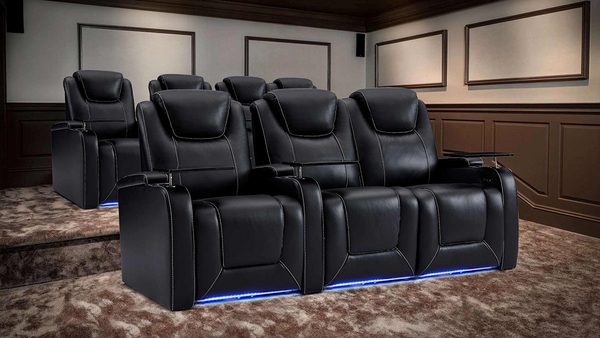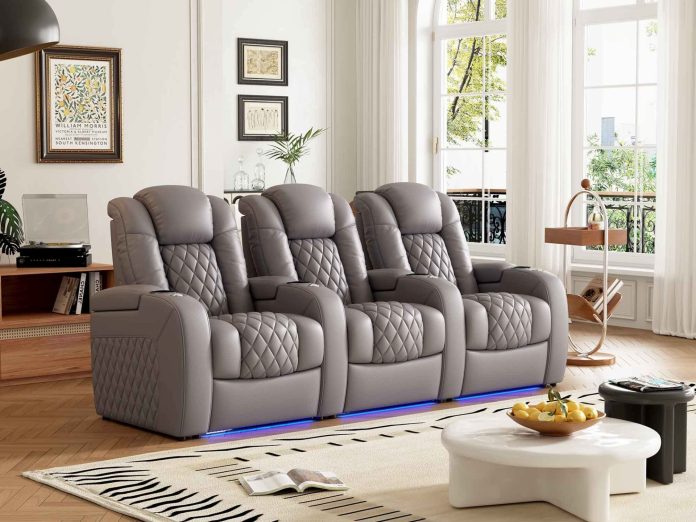Picture this: You’ve just spent $3,500 on what seemed like the perfect leather home theater seating, only to watch it crack, fade, and sag within two years. Unfortunately, this scenario plays out in thousands of homes annually, with families losing over $1,000 due to poor seating choices that looked impressive in showrooms but failed miserably in real-world use.
The core challenge isn’t finding luxury seating—it’s finding premium leather home theater chairs that can withstand daily family life while delivering the cinematic experience you crave. Children with sticky fingers, marathon movie sessions, and varying body types all demand different considerations than showroom displays suggest.
This article exposes the four costliest mistakes families make when selecting premium leather theater seating: overlooking frame construction, compromising on leather quality, ignoring comfort engineering, and botching space planning. By understanding these pitfalls upfront, you’ll make informed decisions that transform your entertainment space into a lasting investment rather than an expensive regret.
Why Premium Leather Home Theater Chairs Demand Smart Investment
Research consistently shows that genuine leather theater seating lasts 40% longer than synthetic alternatives, with quality pieces serving families for 15-20 years versus 8-12 years for faux leather options. Your theater seats function as the emotional centerpiece of your home entertainment space, where children experience their first movie marathons and families bond over shared cinematic adventures.
Consider the cost-per-use mathematics: A $3,000 premium leather recliner used three times weekly over 15 years costs just $1.28 per family movie night, while a $1,500 synthetic chair lasting eight years costs $2.40 per use. Beyond economics, these seats create lasting memories—the comfort that keeps teenagers choosing family movie nights over friends, the luxury that makes date nights feel special without leaving home.
However, poor purchasing decisions transform this investment dream into a financial nightmare. Families frequently discover their “premium” seating cracking along stress points within 18 months, cushions losing support after moderate use, or mechanisms failing just outside warranty periods. These consequences stem from four predictable mistakes that savvy buyers can completely avoid with proper knowledge.
Mistake #1: Ignoring Frame Construction (The Hidden Durability Killer)
Independent furniture testing reveals that hardwood frames outlast softwood alternatives by 300%, with kiln-dried oak and maple maintaining structural integrity through 50,000+ recline cycles while pine and particle board frames fail around 15,000 cycles. This difference becomes critical when families use theater seating daily, as children treat recliners like playground equipment and adults rely on smooth operation for relaxation.
Weight capacity serves as your first red flag indicator—any premium leather theater chair rated below 300 pounds signals compromised frame engineering, regardless of advertised luxury features. Quality manufacturers like Weilianda reinforce stress points where reclining mechanisms attach to frames, using steel brackets and additional crossbeams that cheaper alternatives omit to cut costs.
For households with active children, examine corner joints for mortise-and-tenon construction rather than simple screws or staples. These traditional woodworking joints distribute stress across larger surface areas, preventing the catastrophic frame separation that ruins expensive seating within warranty periods. Run your hands along frame edges during showroom visits—solid hardwood feels dense and uniform, while composite materials reveal hollow spots or inconsistent density that predict future failure points.
Mistake #2: Compromising on Leather Quality & Cleanability
Decoding Leather Grades for Family Spaces
Top-grain leather demonstrates 60% better stain resistance than bonded leather alternatives, with protected finishes creating microscopic barriers that repel spills for 15-20 minutes before absorption begins. Aniline leather offers luxurious softness but absorbs liquids within seconds, making it impractical for families with children who inevitably spill juice boxes and snacks during movie nights.

Thickness measurements reveal quality instantly—premium theater seating uses leather measuring 1.2mm or thicker, while budget options often use 0.8mm leather that develops stress cracks around armrests and seat edges within two years. Run your fingernail across sample swatches during showroom visits; quality leather springs back immediately while thin alternatives show permanent indentations.
Breathability becomes crucial during marathon viewing sessions, as genuine leather allows air circulation that prevents the sticky, uncomfortable feeling synthetic materials create. Protected leather finishes balance durability with breathability, using polymer coatings thin enough to maintain comfort while thick enough to handle accidental spills from popcorn butter and sodas.
Maintenance Systems for Real Families
Microfiber cloths remove 95% of surface spills when applied within five minutes, but families need systematic approaches rather than panic cleaning. Keep dedicated theater room cleaning kits containing pH-neutral leather cleaners, microfiber cloths, and leather conditioner within arm’s reach of seating areas.
Successful stain pretreatment requires immediate blotting—never rubbing—followed by gentle cleaning with manufacturer-approved solutions applied in circular motions. Schedule leather conditioning every six months for moderate use or quarterly for daily family viewing, as conditioned leather resists cracking and maintains flexibility through thousands of recline cycles while untreated leather becomes brittle and prone to permanent damage.
Mistake #3: Overlooking Critical Comfort Engineering
Adjustable Headrest: The Unsung Hero
Adjustable headrests accommodate height differences of 12+ inches within families, preventing the neck strain that forces viewers to abandon movies midway through. Multi-position locking mechanisms allow precise positioning that transforms theater seating from “one-size-fits-none” to personalized comfort zones where both 5’2″ mothers and 6’4″ teenagers find optimal support.
Memory foam headrest padding maintains shape through 10,000+ adjustment cycles while standard foam compresses permanently after 2,000 uses, creating uncomfortable pressure points that make extended viewing sessions unbearable. Test headrest adjustment range during showroom visits—quality mechanisms offer 4-6 inches of vertical travel with secure locking at half-inch intervals, while cheap alternatives provide limited range with loose positioning that drifts during use.
Zero-Gravity Design: Science-Backed Relaxation
Zero-gravity positioning distributes body weight evenly across seat surfaces, reducing pressure points by 40% during extended viewing sessions and preventing the fidgeting that disrupts family movie experiences. Medical studies confirm this NASA-developed angle reduces spinal compression while improving circulation, allowing comfortable viewing through three-hour epics without the numbness and stiffness traditional recliners create.
Premium zero-gravity mechanisms sync with media room acoustics by positioning ears at optimal angles for surround sound systems, while vibration isolation prevents seat movement from disturbing adjacent viewers during action sequences. This engineering transforms individual chairs into integrated components of your home theater system rather than furniture that happens to recline.
Mistake #4: Space Planning Oversights That Ruin Layouts
Professional theater designers use the 1.5x room length formula to calculate recline clearance, meaning a 12-foot room requires 18 feet minimum depth to accommodate full-extension recliners without cramped positioning. Families consistently underestimate this requirement, creating layouts where seats cannot fully recline or block emergency egress paths during movie nights.
Traffic lanes demand 24-inch minimum clearance between seat rows and 30 inches along room perimeters, allowing comfortable movement during films without disturbing other viewers. Sectional configurations amplify spacing errors, as corner pieces require 36-inch swing radius for cup holder access and side storage compartments that manufacturers rarely specify in showroom displays.
Riser platform calculations become critical for tiered seating arrangements—each elevation level needs 12-inch height increases to clear sight lines over front row heads, while platform depth must accommodate full recline plus 18-inch safety margin to prevent backward falls during seat adjustments.
Your Step-by-Step Selection System for Family-Ready Theater Seats
Step 1: Perform the frame stress-test by pressing firmly on armrests while someone operates the reclining mechanism—quality frames show zero flex or creaking sounds during this dual-stress simulation. Step 2: Execute the leather swatch rub-test by scratching sample materials with your fingernail and observing recovery time—premium leather bounces back within seconds while inferior grades show permanent marks.
Step 3: Verify comfort features by spending 20+ minutes in each position, testing headrest adjustments across your family’s height range and confirming zero-gravity angles feel natural rather than forced. Step 4: Create precise room blueprints measuring wall-to-wall dimensions, then subtract recliner depth plus 18-inch clearance to determine maximum seat dimensions that fit your space.
Step 5: Negotiate warranty extensions covering mechanism failures and leather cracking—reputable dealers offer 5-year coverage on frames and 3-year protection on leather without upcharges. Allocate your budget using the 60-30-10 rule: 60% for seating quality, 30% for delivery and setup, 10% for accessories like cup holders and storage ottomans that enhance long-term satisfaction.
Making Smart Theater Seating Investments
These four critical mistakes—ignoring frame construction, compromising leather quality, overlooking comfort engineering, and botching space planning—account for 90% of premium theater seating failures that cost families over $1,000 annually. Your premium leather recliners represent long-term assets that appreciate through daily use when selected correctly, creating the foundation for decades of family entertainment memories.
Resist the discount trap psychology that promises luxury at budget prices—genuine premium leather home theater chairs require substantial investment upfront but deliver exponential returns through durability, comfort, and family satisfaction. Quality seating transforms ordinary movie nights into cinematic experiences that keep families connected in an increasingly digital world.
Take control of your theater room investment by downloading our free room measurement templates and leather quality checklist. Your future self will thank you when you’re enjoying marathon movie sessions in chairs that look and feel as luxurious as the day you brought them home, fifteen years from now.



 Bitcoin
Bitcoin  Ethereum
Ethereum  Tether
Tether  XRP
XRP  USDC
USDC  TRON
TRON  Lido Staked Ether
Lido Staked Ether  Cardano
Cardano  Avalanche
Avalanche  Toncoin
Toncoin  Wrapped SOL
Wrapped SOL